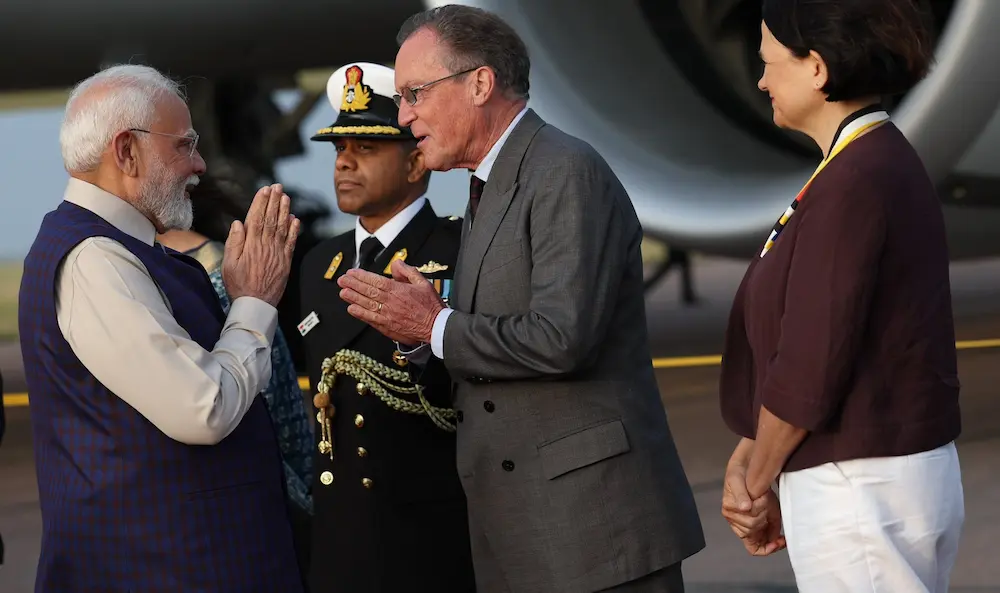
Prime Minister Narendra Modi’s visit to London culminated in the signing of a landmark India-UK Free Trade Agreement
Introduction: A Historic Handshake Across Continents
India-UK Free Trade Agreement – On July 24, 2025, Prime Minister Narendra Modi and UK Prime Minister Keir Starmer signed a landmark Free Trade Agreement (FTA) in London, marking a pivotal moment in India-UK relations. Finalized after three years of negotiations, the deal is expected to boost bilateral trade by $34 billion annually, eliminate tariffs on 99% of Indian exports, and open new doors for strategic cooperation across sectors.
Modi’s arrival was met with warmth and celebration from the Indian diaspora, setting the tone for a partnership rooted in shared values, economic ambition, and global relevance.
Timeline: From Diwali Deadlines to Diplomatic Breakthroughs
- May 2021: Talks initiated under the “Enhanced Trade Partnership” by Boris Johnson and Modi
- May 2025: Agreement finalized in principle
- July 2025: Cabinet approvals secured; deal signed at Chequers, UK
- 2026: Implementation expected post ratification by UK Parliament
This FTA is India’s first major trade deal with a Western economy in over a decade and the UK’s third-largest post-Brexit agreement, following deals with Australia and Japan.
Key Provisions: What the Deal Covers
Tariff Reductions
| Sector | India’s Gains | UK’s Gains |
|---|---|---|
| Textiles & Apparel | Zero-duty access to UK market | Lower import costs for British retailers |
| Gems & Jewellery | Tariff elimination (up to 16%) | Boost for Indian exporters |
| Scotch Whisky & Gin | Duties cut from 150% to 75%, then 40% | Major win for UK distillers like Diageo |
| Automobiles | Tariffs cut from 100%+ to 10% (quota-based) | Easier entry for luxury carmakers |
| Pharma & Medical Devices | Improved UK market access | Lower costs for British healthcare |
Services & Mobility
- 1,800 UK visas for Indian professionals (chefs, yoga instructors, IT experts, musicians)
- 3-year exemption from UK social security contributions for short-term Indian workers
- Enhanced access for Indian IT, finance, and education services
Public Procurement
- UK firms can bid on non-sensitive Indian government tenders worth over ₹4 lakh crore annually
Strategic & Sectoral Cooperation
The FTA goes beyond trade, laying the foundation for collaboration in:
- Green energy & climate innovation
- Defence & cybersecurity
- Education & skill development
- Electric vehicles & clean tech
The launch of the UK-India Vision 2035 signals a long-term commitment to shared growth and geopolitical alignment.
Economic Impact: Numbers That Matter
- India’s GDP boost: Estimated at ₹32,000–₹74,000 crore by 2035
- UK’s GDP gain: £4.8 billion annually
- Trade target: $120 billion by 2030
- Employment: Revitalization of labour-intensive sectors like textiles, footwear, and auto components
Geopolitical Significance
This deal is not just economic — it’s strategic:
- Post-Brexit Britain: Strengthens UK’s “Global Britain” agenda
- India’s global positioning: Adds to FTAs with UAE and Australia, reinforcing its role in Indo-Pacific trade frameworks
- China counterbalance: Deepens India-UK ties amid shifting global power dynamics
Voices from the Ground
“Today is a historic day in India-UK relations… a comprehensive economic and trade agreement has been reached.” Prime Minister Narendra Modi
“Our landmark trade deal with India is a major win for Britain.” Prime Minister Keir Starmer
Challenges Ahead
While the FTA is ambitious, execution will require:
- Regulatory alignment across sectors
- Ratification by UK Parliament
- Monitoring of sensitive sectors like agriculture and dairy, which remain excluded
Final Thoughts: A Partnership Reimagined
The India-UK Free Trade Agreement is more than a document, it’s a blueprint for shared prosperity. By blending tariff liberalization with strategic safeguards, it reflects a mature, forward-looking partnership between two democracies.
As Modi meets with King Charles III and engages with British leadership, the message is clear: India and the UK are ready to lead together in trade, innovation, and global diplomacy.
What is the India-UK Free Trade Agreement and why is it significant?
Signed in July 2025, the FTA aims to boost bilateral trade to $120 billion by 2030, eliminate tariffs on 99% of Indian exports, and deepen strategic cooperation across sectors like green energy, defence, and education.
Which sectors benefit most from the India-UK FTA?
India gains duty-free access for textiles, gems, auto components, footwear, and processed foods, while the UK benefits from reduced tariffs on Scotch whisky, automobiles, medical devices, and cosmetics.
Does the FTA include provisions for professional mobility?
Yes. The agreement allows 1,800 UK visas annually for Indian professionals such as chefs, yoga instructors, and IT experts, along with a 3-year exemption from UK social security contributions for short-term workers.
Are any sectors excluded from the agreement?
India has excluded sensitive items like dairy, apples, and edible oils to protect domestic farmers. Some industrial goods like plastics and smartphones are also on the exclusion list.
When will the India–UK FTA be implemented?
Following legal review and ratification by both governments, the FTA is expected to be implemented in early 2026, with phased tariff reductions and mobility provisions rolling out over the next decade.
Stay updated with the latest news on Rapido Updates. Keep yourself updated with The World, India News, Entertainment, Market, Automobile, Gadgets, Sports, and many more